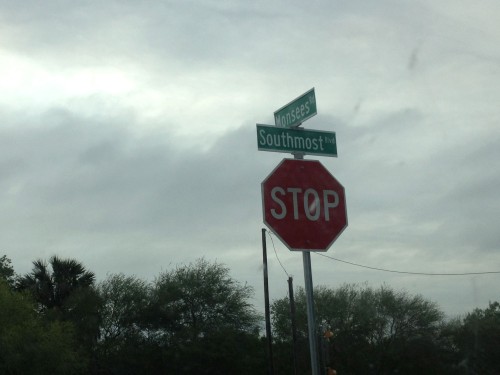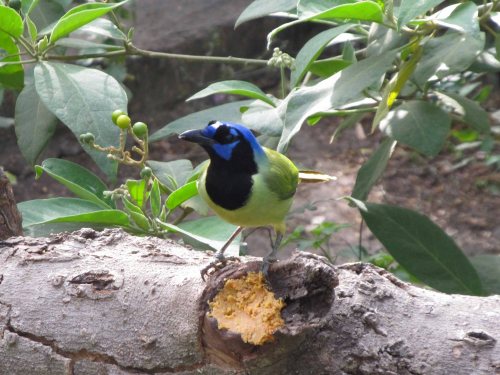If the Hill Country is the Heart of Texas, then the area around Brownsville and South Padre Island (in the extreme southeastern part of the state) is its Big Toe. You know the one I’m talking about – that toe that always peeks out from the sandal, loves getting a good tan, and enjoys digging in the wet sand? I’ve spent the last couple days exploring the Texas Toe, and seeing what it has to offer.
One of my first stops was the Sabal Palm Audubon Sanctuary, south of Brownsville. There is not a lot of land in Texas south of Brownsville, but there is a thin little strip, and Sabal Palm is located there. In order to get there, I’d have to take the most appropriately named Southmost Blvd.
It was here that I came face-to-face with the famous (or infamous) Border Fence that the US Government has been building along our shared border with Mexico. The fence is a scary monstrosity. It is very tall, made of rusty-looking iron, and topped with spikes. Trees, habitat, and farmland on either side have been cleared. South of Brownsville the fence is actually built quite a distance from the Rio Grande, essentially sealing off a sliver of US land south of the border wall. Sabal Palm Sanctuary is south of the fence, and you have to pass through a kind of checkpoint to reach it.
I tried to put this unsettling experience behind me for now, and enjoy my time at the Sanctuary. Sabal Palm is one of the few remaining tracks of wild habitat left in the eastern end of the Rio Grande Valley, and it is home to a forest of rare native sabal palm trees. It is also a magnet for rare and beautiful birds.
I saw the rarest one first, a female Crimson-collared Grosbeak. Common in parts of Mexico, this bird only very occasionally ventures as far north as the Brownsville area. This particular individual liked to skulk deep in the brush while I was there, so all I managed was this less than serviceable photo:
As you can see, her collar is green. Only the male’s is crimson. Her shy attitude and my persistent efforts to snap a photo made me feel a bit like one of those annoying photographers who is always trying to take a picture of some poor celebrity while she tries to get an ice cream with her kids.
The more common birds were more cooperative, like Green Jay and Hooded Oriole. Bird snacks, provided by the refuge staff, helped them feel at home near the human visitors.
That apple that the oriole was munching was popular, and as soon as he left a rare Clay-colored Thrush came in to have a bite.
After spending a couple of hours at Sabal Palm, I negotiated my way back through the border fence and headed east to the coast. Along the way, I scanned for Aplomado Falcons.
Aplomado Falcons used to be fairly common from south Texas to Arizona in the 19th Century, but perhaps because of cattle grazing, land clearing, and/or hunting, the birds were essentially extirpated (i.e. eliminated) from the United States. In the 1980s, a re-introduction effort was launched, with captive-raised birds being released in southeast Texas. The re-introduction seems to be working, and there are now a couple dozen Aplomado Falcons roaming wild in the area. I have searched for Aplomados on every trip to Texas over the last ten years, including back in February when I was here. This is my seventh trip overall, and I’ve missed seeing them on the previous six. Birders call species that they miss repeatedly “nemesis birds” – and Aplomados were probably my #1 nemesis. Needless to say, I wasn’t too hopeful. There just aren’t that many of these falcons around, and they range over a wide area. They are also relatively small, and they are fast flyers – easy to miss. So when I saw a dark raptor zipping by me on Highway 100, I tried not to get excited as I pulled off the highway into the grassy shoulder (I had previously stopped for a distant Caracara and a couple of Chihuahuan Ravens, thinking they might be falcons). Focusing my binoculars, I caught a quick glimpse of a sharp-winged falcon blasting by at perhaps 60 mph – in hot pursuit of some Horned Larks, one of which was about to become lunch on the wing. It was an Aplomado Falcon.
It was too fast and too far away to get a good photo, but here is a super blurry picture of this magnificent creature. I watched it devour a Horned Lark, and then fly up to an electrical tower where there was a nest made of sticks. And poking up from inside that nest was the tail of a second Aplomado Falcon, presumably sitting on eggs (or chicks!). I had found an Aplomado nest!
Aplomados have extremely long tails, mostly dark with thin white stripes – as you can see in the photo above! I was thrilled. I also decided I shouldn’t linger. Even though I was still almost 200 yards away, birds of prey can get antsy when people get too close to their nests – and Aplomado Falcons are an endangered species. So I did a little fist pump, put the car in gear, and headed for South Padre Island.
There’s more to tell about this leg of the trip, but it’s late and tomorrow is another early morning. I doubt it can possibly top today, though.










Pingback: Migration Miracle | Periodic Wanderings